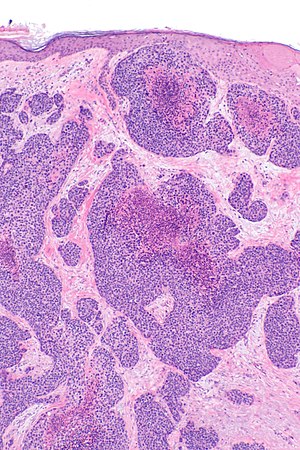Difference between revisions of "Porocarcinoma"
Jump to navigation
Jump to search
| (2 intermediate revisions by the same user not shown) | |||
| Line 10: | Line 10: | ||
[[adenocarcinoma]], [[malignant melanoma]] | [[adenocarcinoma]], [[malignant melanoma]] | ||
| Stains = | | Stains = | ||
| IHC = | | IHC = [[CD117]] +ve | ||
| EM = | | EM = | ||
| Molecular = | | Molecular = | ||
| Line 71: | Line 71: | ||
===Images=== | ===Images=== | ||
<gallery> | <gallery> | ||
Image: Porocarcinoma -- very low mag.jpg | Porocarcinoma - very low mag. | Image: Porocarcinoma -- very low mag.jpg | Porocarcinoma - very low mag. | ||
| Line 81: | Line 80: | ||
</gallery> | </gallery> | ||
===www=== | ====www==== | ||
*[https://www.ncbi.nlm.nih.gov/pmc/articles/PMC5595608/figure/f4/?report=objectonly Eccrine porocarcinoma (nih.gov)].<ref name=pmid28954110/> | *[https://www.ncbi.nlm.nih.gov/pmc/articles/PMC5595608/figure/f4/?report=objectonly Eccrine porocarcinoma (nih.gov)].<ref name=pmid28954110/> | ||
*[https://www.ncbi.nlm.nih.gov/pmc/articles/PMC3884174/figure/F2/ Porocarcinoma (nih.gov)].<ref name=pmid24403888>{{Cite journal | last1 = Kurashige | first1 = Y. | last2 = Minemura | first2 = T. | last3 = Nagatani | first3 = T. | title = Eccrine porocarcinoma: clinical and pathological report of eight cases. | journal = Case Rep Dermatol | volume = 5 | issue = 3 | pages = 259-66 | month = | year = 2013 | doi = 10.1159/000355606 | PMID = 24403888 }}</ref> | *[https://www.ncbi.nlm.nih.gov/pmc/articles/PMC3884174/figure/F2/ Porocarcinoma (nih.gov)].<ref name=pmid24403888>{{Cite journal | last1 = Kurashige | first1 = Y. | last2 = Minemura | first2 = T. | last3 = Nagatani | first3 = T. | title = Eccrine porocarcinoma: clinical and pathological report of eight cases. | journal = Case Rep Dermatol | volume = 5 | issue = 3 | pages = 259-66 | month = | year = 2013 | doi = 10.1159/000355606 | PMID = 24403888 }}</ref> | ||
==IHC== | |||
Features:<ref>{{Cite journal | last1 = Goto | first1 = K. | last2 = Takai | first2 = T. | last3 = Fukumoto | first3 = T. | last4 = Anan | first4 = T. | last5 = Kimura | first5 = T. | last6 = Ansai | first6 = S. | last7 = Oshitani | first7 = Y. | last8 = Murata | first8 = Y. | last9 = Sakuma | first9 = T. | title = CD117 (KIT) is a useful immunohistochemical marker for differentiating porocarcinoma from squamous cell carcinoma. | journal = J Cutan Pathol | volume = 43 | issue = 3 | pages = 219-26 | month = Mar | year = 2016 | doi = 10.1111/cup.12632 | PMID = 26449497 }}</ref> | |||
*[[CD117]] +ve (~100% of porocarcinoma, ~20% of [[squamous carcinoma]]s focally). | |||
==See also== | ==See also== | ||
Latest revision as of 19:24, 8 February 2019
| Porocarcinoma | |
|---|---|
| Diagnosis in short | |
 Porocarcinoma. H&E stain. | |
| LM DDx |
basal cell carcinoma, squamous cell carcinoma, pyogenic granuloma, verruca vulgaris, adenocarcinoma, malignant melanoma |
| IHC | CD117 +ve |
| Site | skin - typically head & neck |
|
| |
| Prevalence | very rare |
| Prognosis | poor |
| Treatment | surgical excision |
Porocarcinoma is a rare malignant skin tumour that has an aggressive behaviour.[1]
It is also known as eccrine porocarcinoma (abbreviated EPC) and malignant eccrine poroma.[2]
General
Clinical features - based on meta-analysis of 453 cases:[1]
- No predominance males versus females.
- Aggressive behaviour >30% of cases have metastases at presentation - typically to lymph nodes.
Treatment:
- Surgery,
Gross
- Mass or nodule - typically head and neck (40% of cases) or lower extremity (34% of cases).[1]
Microscopic
Features:
- Ductal/eccrine differentiation:[2]
- Intracytoplasmic lumens.
- Multicellular ducts with thin esoinophilic layer.
- Lack granular cells and lack decapitated lumens - features of apocrine differentiation.
- Features of malignancy:[2]
- Desmoplastic stromal response.
- Irregular dermis infiltrating cell clusters.
- +/-Squamous differentiation.
- +/-Basaloid differentiation.
DDx:[3]
- Basal cell carcinoma.
- Squamous cell carcinoma.
- Pyogenic granuloma.
- Verruca vulgaris.
- Adenocarcinoma.
- Malignant melanoma - desmoplastic and nodular variants.
Images
www
IHC
Features:[6]
- CD117 +ve (~100% of porocarcinoma, ~20% of squamous carcinomas focally).
See also
References
- ↑ 1.0 1.1 1.2 Salih, AM.; Kakamad, FH.; Baba, HO.; Salih, RQ.; Hawbash, MR.; Mohammed, SH.; Othman, S.; Saeed, YA. et al. (Aug 2017). "Porocarcinoma; presentation and management, a meta-analysis of 453 cases.". Ann Med Surg (Lond) 20: 74-79. doi:10.1016/j.amsu.2017.06.027. PMID 28721214.
- ↑ 2.0 2.1 2.2 Luz, Mde A.; Ogata, DC.; Montenegro, MF.; Biasi, LJ.; Ribeiro, LC. (Jul 2010). "Eccrine porocarcinoma (malignant eccrine poroma): a series of eight challenging cases.". Clinics (Sao Paulo) 65 (7): 739-42. doi:10.1590/S1807-59322010000700014. PMID 20668633.
- ↑ 3.0 3.1 3.2 Abarzúa, Á.; Álvarez-Véliz, S.; Moll-Manzur, C.. "Concomitant poroma and porocarcinoma.". An Bras Dermatol 92 (4): 550-552. doi:10.1590/abd1806-4841.20175719. PMID 28954110.
- ↑ Riera-Leal, L.; Guevara-Gutiérrez, E.; Barrientos-García, JG.; Madrigal-Kasem, R.; Briseño-Rodríguez, G.; Tlacuilo-Parra, A. (2015). "Eccrine porocarcinoma: epidemiologic and histopathologic characteristics.". Int J Dermatol 54 (5): 580-6. doi:10.1111/ijd.12714. PMID 25515648.
- ↑ Kurashige, Y.; Minemura, T.; Nagatani, T. (2013). "Eccrine porocarcinoma: clinical and pathological report of eight cases.". Case Rep Dermatol 5 (3): 259-66. doi:10.1159/000355606. PMID 24403888.
- ↑ Goto, K.; Takai, T.; Fukumoto, T.; Anan, T.; Kimura, T.; Ansai, S.; Oshitani, Y.; Murata, Y. et al. (Mar 2016). "CD117 (KIT) is a useful immunohistochemical marker for differentiating porocarcinoma from squamous cell carcinoma.". J Cutan Pathol 43 (3): 219-26. doi:10.1111/cup.12632. PMID 26449497.





